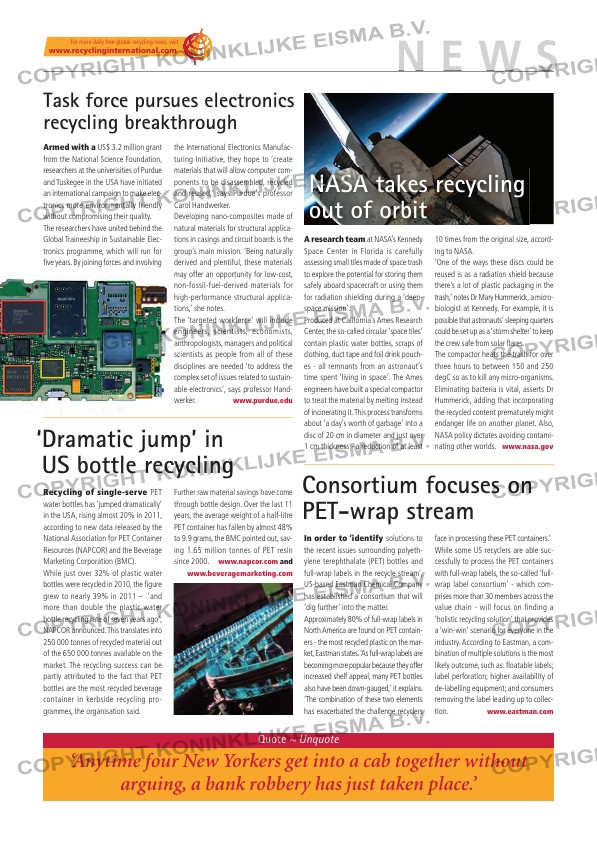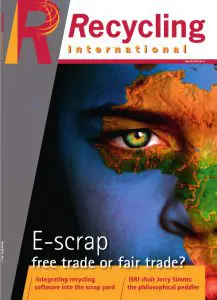Page 17 from: March 2013

N E W S
For more daily free global recycling news, visit
www.recyclinginternational.com
Recycling of single-serve PET
water bottles has ‘jumped dramatically’
in the USA, rising almost 20% in 2011,
according to new data released by the
National Association for PET Container
Resources (NAPCOR) and the Beverage
Marketing Corporation (BMC).
While just over 32% of plastic water
bottles were recycled in 2010, the fi gure
grew to nearly 39% in 2011 – ‘and
more than double the plastic water
bottle recycling rate of seven years ago’,
NAPCOR announced. This translates into
250 000 tonnes of recycled material out
of the 650 000 tonnes available on the
market. The recycling success can be
partly attributed to the fact that PET
bottles are the most recycled beverage
container in kerbside recycling pro-
grammes, the organisation said.
Further raw material savings have come
through bottle design. Over the last 11
years, the average weight of a half-litre
PET container has fallen by almost 48%
to 9.9 grams, the BMC pointed out, sav-
ing 1.65 million tonnes of PET resin
since 2000. www.napcor.com and
www.beveragemarketing.com
‘ Dramatic jump’ in
US bottle recycling
A research team at NASA’s Kennedy
Space Center in Florida is carefully
assessing small tiles made of space trash
to explore the potential for storing them
safely aboard spacecraft or using them
for radiation shielding during a ‘deep-
space mission’.
Produced at California’s Ames Research
Center, the so-called circular ‘space tiles’
contain plastic water bottles, scraps of
clothing, duct tape and foil drink pouch-
es – all remnants from an astronaut’s
time spent ‘living in space’. The Ames
engineers have built a special compactor
to treat the material by melting instead
of incinerating it. This process transforms
about ‘a day’s worth of garbage’ into a
disc of 20 cm in diameter and just over
1 cm thickness – a reduction of at least
10 times from the original size, accord-
ing to NASA.
‘One of the ways these discs could be
reused is as a radiation shield because
there’s a lot of plastic packaging in the
trash,’ notes Dr Mary Hummerick, a micro-
biologist at Kennedy. For example, it is
possible that astronauts’ sleeping quarters
could be set up as a ‘storm shelter’ to keep
the crew safe from solar fl ares.
The compactor heats the trash for over
three hours to between 150 and 250
degC so as to kill any micro-organisms.
Eliminating bacteria is vital, asserts Dr
Hummerick, adding that incorporating
the recycled content prematurely might
endanger life on another planet. Also,
NASA policy dictates avoiding contami-
nating other worlds. www.nasa.gov
NASA takes recycling
out of orbit
In order to ‘identify solutions to
the recent issues surrounding polyeth-
ylene terephthalate (PET) bottles and
full-wrap labels in the recycle stream’,
US-based Eastman Chemical Company
has established a consortium that will
‘dig further’ into the matter.
Approximately 80% of full-wrap labels in
North America are found on PET contain-
ers – the most recycled plastic on the mar-
ket, Eastman states. ‘As full-wrap labels are
becoming more popular because they offer
increased shelf appeal, many PET bottles
also have been down-gauged,’ it explains.
‘The combination of these two elements
has exacerbated the challenge recyclers
face in processing these PET containers.’
While some US recyclers are able suc-
cessfully to process the PET containers
with full-wrap labels, the so-called ‘full-
wrap label consortium’ – which com-
prises more than 30 members across the
value chain – will focus on finding a
‘holistic recycling solution’ that provides
a ‘win-win’ scenario for everyone in the
industry. According to Eastman, a com-
bination of multiple solutions is the most
likely outcome, such as: fl oatable labels;
label perforation; higher availability of
de-labelling equipment; and consumers
removing the label leading up to collec-
tion. www.eastman.com
Consortium focuses on
PET-wrap stream
Armed with a US$ 3.2 million grant
from the National Science Foundation,
researchers at the univerisities of Purdue
and Tuskegee in the USA have initiated
an international campaign to make elec-
tronics more environmentally friendly
without compromising their quality.
The researchers have united behind the
Global Traineeship in Sustainable Elec-
tronics programme, which will run for
fi ve years. By joining forces and involving
the International Electronics Manufac-
turing Initiative, they hope to ‘create
materials that will allow computer com-
ponents to be disassembled, recycled
and reused,’ says Purdue’s professor
Carol Handwerker.
Developing nano-composites made of
natural materials for structural applica-
tions in casings and circuit boards is the
group’s main mission. ‘Being naturally
derived and plentiful, these materials
may offer an opportunity for low-cost,
non-fossil-fuel-derived materials for
high-performance structural applica-
tions,’ she notes.
The ‘targeted workforce’ will include
engineers, scientists, economists,
anthropologists, managers and political
scientists as people from all of these
disciplines are needed ‘to address the
complex set of issues related to sustain-
able electronics’, says professor Hand-
werker. www.purdue.edu
Task force pursues electronics
recycling breakthrough
‘Anytime four New Yorkers get into a cab together without
arguing, a bank robbery has just taken place.’
Quote ~ Unquote
RI_2-NEWS.indd 17 06-03-13 09:35



